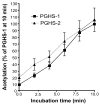Acetylation of prostaglandin H2 synthases by aspirin is inhibited by redox cycling of the peroxidase
- PMID: 18242581
- PMCID: PMC2693035
- DOI: 10.1016/j.bcp.2007.12.005
Acetylation of prostaglandin H2 synthases by aspirin is inhibited by redox cycling of the peroxidase
Abstract
Aspirin exerts its unique pharmacological effects by irreversibly acetylating a serine residue in the cyclooxygenase site of prostaglandin-H2-synthases (PGHSs). Despite the irreversibility of the inhibition, the potency of aspirin varies remarkably between cell types, suggesting that molecular determinants could contribute to cellular selectivity. Using purified enzymes, we found no evidence that aspirin is selective for either of the two PGHS isoforms, and we showed that hydroperoxide substrates of the PGHS peroxidase inhibited the rate of acetylation of PGHS-1 by 68%. Using PGHS-1 reconstituted with cobalt protoporphyrin, a heme devoid of peroxidase activity, we demonstrated that reversal by hydroperoxides of the aspirin-mediated acetylation depends upon the catalytic activity of the PGHS peroxidase. We demonstrated that inhibition of PGHS-2 by aspirin in cells in culture is reversed by 12-hydroperoxyeicosatetraenoic acid dose-dependently (ED50=0.58+/-0.15 microM) and that in cells with high levels of hydroperoxy-fatty acids (RAW264.7) the efficacy of aspirin is markedly decreased as compared to cells with low levels of hydroperoxides (A549; IC50s=256+/-22 microM and 11.0+/-0.9 microM, respectively). Together, these findings indicate that acetylation of the PGHSs by aspirin is regulated by the catalytic activity of the peroxidase, which yields a higher oxidative state of the enzyme.
Figures







Similar articles
-
Inhibition of prostaglandin H2 synthases by salicylate is dependent on the oxidative state of the enzymes.J Pharmacol Exp Ther. 2003 Feb;304(2):589-95. doi: 10.1124/jpet.102.042853. J Pharmacol Exp Ther. 2003. PMID: 12538810
-
Comparison of peroxidase reaction mechanisms of prostaglandin H synthase-1 containing heme and mangano protoporphyrin IX.J Biol Chem. 1997 Apr 4;272(14):8885-94. doi: 10.1074/jbc.272.14.8885. J Biol Chem. 1997. PMID: 9083007
-
Analysis of hydroperoxide-induced tyrosyl radicals and lipoxygenase activity in aspirin-treated human prostaglandin H synthase-2.Biochemistry. 1997 Feb 18;36(7):1836-45. doi: 10.1021/bi962476u. Biochemistry. 1997. PMID: 9048568
-
Paracetamol (Acetaminophen): mechanisms of action.Paediatr Anaesth. 2008 Oct;18(10):915-21. doi: 10.1111/j.1460-9592.2008.02764.x. Paediatr Anaesth. 2008. PMID: 18811827 Review.
-
[Direction of strategic use: a new classification of non-steroidal anti-inflammatory drugs based on reactivity with peroxidase].Yakugaku Zasshi. 2013;133(6):681-9. doi: 10.1248/yakushi.12-00277. Epub 2013 Mar 9. Yakugaku Zasshi. 2013. PMID: 23474686 Review. Japanese.
Cited by
-
Structural basis for certain naturally occurring bioflavonoids to function as reducing co-substrates of cyclooxygenase I and II.PLoS One. 2010 Aug 23;5(8):e12316. doi: 10.1371/journal.pone.0012316. PLoS One. 2010. PMID: 20808785 Free PMC article.
-
Cyclooxygenase Allosterism, Fatty Acid-mediated Cross-talk between Monomers of Cyclooxygenase Homodimers.J Biol Chem. 2009 Apr 10;284(15):10046-55. doi: 10.1074/jbc.M808634200. Epub 2009 Feb 12. J Biol Chem. 2009. PMID: 19218248 Free PMC article.
-
Suboptimal inhibition of platelet cyclooxygenase-1 by aspirin in metabolic syndrome.Hypertension. 2012 Mar;59(3):719-25. doi: 10.1161/HYPERTENSIONAHA.111.181404. Epub 2012 Feb 6. Hypertension. 2012. PMID: 22311905 Free PMC article. Clinical Trial.
-
Identification and absolute configuration of dihydroxy-arachidonic acids formed by oxygenation of 5S-HETE by native and aspirin-acetylated COX-2.J Lipid Res. 2010 Mar;51(3):575-85. doi: 10.1194/jlr.M001719. Epub 2009 Sep 14. J Lipid Res. 2010. PMID: 19752399 Free PMC article.
-
Inhibition of the Biosynthesis of Prostaglandin E2 By Low-Dose Aspirin: Implications for Adenocarcinoma Metastasis.Cancer Prev Res (Phila). 2016 Nov;9(11):855-865. doi: 10.1158/1940-6207.CAPR-16-0094. Epub 2016 Aug 23. Cancer Prev Res (Phila). 2016. PMID: 27554763 Free PMC article.
References
-
- Smith WL, Lands WE. Stimulation and blockade of prostaglandin biosynthesis. J Biol Chem. 1971;246:6700–2. - PubMed
-
- Lecomte M, Laneuville O, Ji C, DeWitt DL, Smith WL. Acetylation of human prostaglandin endoperoxide synthase-2 (cyclooxygenase-2) by aspirin. J Biol Chem. 1994;269:13207–15. - PubMed
-
- Roth GJ, Machuga ET, Ozols J. Isolation and covalent structure of the aspirin-modified, active-site region of prostaglandin synthetase. Biochemistry. 1983;22:4672–5. - PubMed
Publication types
MeSH terms
Substances
Grants and funding
LinkOut - more resources
Full Text Sources
Other Literature Sources
Research Materials

